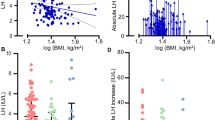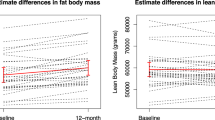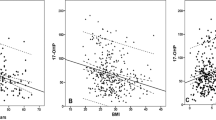Abstract
OBJECTIVE:
Bone modulates testis function through osteocalcin (OCN) production. This paper assesses the association between serum OCN and androgen production recovery in morbidly obese males at 9 months after bariatric surgery.
SUBJECTS:
A cohort of n=103 obese males with mean±s.d. body mass index (BMI) 47.7±8.2 kg m–2, age 42±11 years, consisting of n=76 patients undergoing gastric bypass and n=27 in the waiting list for surgery.
RESULTS:
At 9 months from surgery, a significant increase was observed in mean±s.d. total OCN (tOCN=10.4±10.3 ng ml–1, P<0.001) and undercarboxylated OCN (ucOCN=5.4±3.7 ng ml–1, P<0.001), total testosterone (TT, 5.6±6.5 nM, P<0.001) and calculated free testosterone (cFT, 0.035±0.133 nM, P<0.006), sex hormone binding globulin (SHBG, 21.2±16.7 nM, P<0.001) and decrease in estradiol (E2, −30.1±51.9 pM, P<0.001) levels only in operated patients, with a significant reduction in BMI (24%) and waist (20%). A positive correlation existed between tOCN and ucOCN (age-adjustment (age-adj.): β=0.692, P<0.001) and their variations (age-adj.: β=0.629, P<0.001) after surgery. Multivariate analysis in operated patients showed a significant positive association between variations in tOCN and TT (age-adj.: β=0.289, P=0.012), SHBG (age-adj.: β=0.326, P=0.005) but not with cFT variation. tOCN, but not luteinizing hormone (LH) variation was the only significant predictive factor of cFT recovery in the hypogonadal (TT<12 nM) operated subjects even after age- and BMI-adjustment (adj.: β=0.582, P<0.05). cFT improvement was significantly higher when considering operated patients with tOCN increase (0.045±0.123 vs −0.02±0.118 nM, P=0.015), hypogonadism (0.059±0.111 vs –0.059±0.138 nM, P=0.002) and younger than 35 years (0.102±0.108 vs –0.019±0.123 nM, P=0.009).
CONCLUSION:
OCN recovery observed after bariatric surgery is significantly associated with cFT improvement independently of BMI variation and age in hypogonadal morbidly obese males.
This is a preview of subscription content, access via your institution
Access options
Subscribe to this journal
Receive 12 print issues and online access
$259.00 per year
only $21.58 per issue
Buy this article
- Purchase on Springer Link
- Instant access to full article PDF
Prices may be subject to local taxes which are calculated during checkout

Similar content being viewed by others
References
Khosla S, Melton LJ 3rd, Atkinson EJ, O'Fallon WM . Relationship of serum sex steroid levels to longitudinal changes in bone density in young versus elderly men. J Clin Endocrinol Metab 2001; 86: 3555–3561.
Nakamura T, Imai Y, Matsumoto T, Sato S, Takeuchi K, Igarashi K et al. Estrogen prevents bone loss via estrogen receptor alpha and induction of Fas ligand in osteoclasts. Cell 2007; 130: 811–823.
Manolagas SC, Kousteni S, Jilka RL . Sex steroids and bone. Recent Prog Horm Res 2002; 57: 385–409.
Oury F, Sumara G, Sumara O, Ferron M, Chang H, Smith CE et al. Endocrine regulation of male fertility by the skeleton. Cell 2011; 144: 796–809.
Smith LB, Saunders PT . The skeleton: the new controller of male fertility? Cell 2011; 144: 642–643.
Kirmani S, Atkinson EJ, Melton LJ 3rd, Riggs BL, Amin S, Khosla S . Relationship of testosterone and osteocalcin levels during growth. J Bone Miner Res 2011; 26: 2212–2216.
Oury F, Ferron M, Huizhen W, Confavreux C, Xu L, Lacombe JS et al. Osteocalcin regulates murine and human fertility through a pancreas-bone-testis axis. J Clin Invest 2013; 123: 2421–2433.
Yang B, Sun H, Wan Y, Wang H, Qin W, Yang L et al. Associations between testosterone, bone mineral density, vitamin D and semen quality in fertile and infertile Chinese men. Int J Androl 2012; 35: 783–792.
Bolland MJ, Grey A, Horne AM, Reid IR . Testosterone levels following decreases in serum osteocalcin. Calcif Tissue Int 2013; 93: 133–136.
Hannemann A, Breer S, Wallaschofski H, Nauck M, Baumeister SE, Barvencik F et al. Osteocalcin is associated with testosterone in the general population and selected patients with bone disorders. Andrology 2013; 1: 469–474.
Liao M, Guo X, Yu X, Pang G, Zhang S, Li J et al. Role of metabolic factors in the association between osteocalcin and testosterone in Chinese men. J Clin Endocrinol Metab 2013; 98: 3463–3469.
Lee NK, Sowa H, Hinoi E, Ferron M, Ahn JD, Confavreux C et al. Endocrine regulation of energy metabolism by the skeleton. Cell 2007; 130: 456–469.
Fernández-Real JM, Izquierdo M, Ortega F, Gorostiaga E, Gómez-Ambrosi J, Moreno-Navarrete JM et al. The relationship of serum osteocalcin concentration to insulin secretion, sensitivity, and disposal with hypocaloric diet and resistance training. J Clin Endocrinol Metab 2009; 94: 237–245.
Saleem U, Mosley TH Jr, Kullo IJ . Serum osteocalcin is associated with measures of insulin resistance, adipokine levels, and the presence of metabolic syndrome. Arterioscler Thromb Vasc Biol 2010; 30: 1474–1478.
Yeap BB, Chubb SA, Flicker L, McCaul KA, Ebeling PR, Beilby JP et al. Reduced serum total osteocalcin is associated with metabolic syndrome in older men via waist circumference, hyperglycemia, and triglyceride levels. Eur J Endocrinol 2010; 63: 265–272.
Pittas AG, Harris SS, Eliades M, Stark P, Dawson-Hughes B . Association between serum osteocalcin and markers of metabolic phenotype. J Clin Endocrinol Metab 2009; 94: 827–832.
Alfadda AA, Masood A, Shaik SA, Dekhil H, Goran M . Association between osteocalcin, metabolic syndrome, and cardiovascular risk factors: role of total and undercarboxylated osteocalcin in patients with type 2 diabetes. Int J Endocrinol 2013; 2013: 197519.
Foresta C, Strapazzon G, De Toni L, Gianesello L, Calcagno A, Pilon C et al. Evidence for osteocalcin production by adipose tissue and its role in human metabolism. J Clin Endocrinol Metab 2010; 95: 3502–3506.
Kanazawa I, Tanaka K, Ogawa N, Yamauchi M, Yamaguchi T, Sugimoto T . Undercarboxylated osteocalcin is positively associated with free testosterone in male patients with type 2 diabetes mellitus. Osteoporos Int 2013; 24: 1115–1119.
Hammoud A, Gibson M, Hunt SC, Adams TD, Carrell DT, Kolotkin RL et al. Effect of Roux-en-Y gastric bypass surgery on the sex steroids and quality of life in obese men. J Clin Endocrinol Metab 2009; 94: 1329–1332.
Luconi M, Samavat J, Seghieri G, Iannuzzi G, Lucchese M, Rotella C et al. Determinants of testosterone recovery after bariatric surgery: is it only a matter of reduction of body mass index? Fertil Steril 2013; 99: 1872–1879.
Pellitero S, Olaizola I, Alastrue A, Martínez E, Granada ML, Balibrea JM et al. Hypogonadotropic hypogonadism in morbidly obese males is reversed after bariatric surgery. Obes Surg 2012; 22: 1835–1842.
Facchiano E, Scaringi S, Veltri M, Samavat J, Maggi M, Forti G et al. Age as a predictive factor of testosterone improvement in male patients after bariatric surgery: preliminary results of a monocentric prospective study. Obes Surg 2013; 23: 167–172.
Corona G, Rastrelli G, Monami M, Saad F, Luconi M, Lucchese M et al. Body weight loss reverts obesity-associated hypogonadotropic hypogonadism: a systematic review and meta-analysis. Eur J Endocrinol 2013; 168: 829–843.
Coates PS, Fernstrom JD, Fernstrom MH, Schauer PR, Greenspan SL . Gastric bypass surgery for morbid obesity leads to an increase in bone turnover and a decrease in bone mass. J Clin Endocrinol Metab 2004; 89: 1061–1065.
Bruno C, Fulford AD, Potts JR, McClintock R, Jones R, Cacucci BM et al. Serum markers of bone turnover are increased at six and 18 months after Roux-en-Y bariatric surgery: correlation with the reduction in leptin. J Clin Endocrinol Metab 2010; 95: 159–166.
Fernández-Real JM, Ortega F, Gómez-Ambrosi J, Salvador J, Frühbeck G, Ricart W . Circulating osteocalcin concentrations are associated with parameters of liver fat infiltration and increase in parallel to decreased liver enzymes after weight loss. Osteoporos Int 2010; 21: 2101–2107.
Huhtaniemi IT, Tajar A, Lee DM, O'Neill TW, Finn JD, Bartfai G et alEMAS Group. Comparison of serum testosterone and estradiol measurements in 3174 European men using platform immunoassay and mass spectrometry; relevance for the diagnostics in aging men. Eur J Endocrinol 2012; 66: 983–991.
Vermeulen A, Verdonck L, Kaufman JM . A critical evaluation of simple methods for the estimation of free testosterone in serum. J Clin Endocrinol Metab 1999; 84: 3666–3672.
Bhasin S, Pencina M, Jasuja GK, Travison TG, Coviello A, Orwoll E et al. Reference ranges for testosterone in men generated using liquid chromatography tandem mass spectrometry in a community-based sample of healthy nonobese young men in the Framingham Heart Study and applied to three geographically distinct cohorts. J Clin Endocrinol Metab 2011; 96: 2430–2439.
Ferron M, Hinoi E, Karsenty G, Ducy P . Osteocalcin differentially regulates beta cell and adipocyte gene expression and affects the development of metabolic diseases in wild-type mice. Proc Natl Acad Sci USA 2008; 105: 5266–5270.
Kim SH, Lee JW, Im JA, Hwang HJ . Serum osteocalcin is related to abdominal obesity in Korean obese and overweight men. Clin Chim Acta 2010; 411: 2054–2057.
Luo XH, Guo LJ, Yuan LQ, Xie H, Zhou HD, Wu XP et al. Adiponectin stimulates human osteoblasts proliferation and differentiation via the MAPK signaling pathway. Exp Cell Res 2005; 309: 99–109.
Oshima K, Nampei A, Matsuda M, Iwaki M, Fukuhara A, Hashimoto J et al. Adiponectin increases bone mass by suppressing osteoclast and activating osteoblast. Biochem Biophys Res Commun 2005; 331: 520–526.
Kajimura D, Lee HW, Riley KJ, Arteaga-Solis E, Ferron M, Zhou B et al. Adiponectin regulates bone mass via opposite central and peripheral mechanisms through FoxO1. Cell Metab 2013; 17: 901–915.
Karsenty G . Convergence between bone and energy homeostases: leptin regulation of bone mass. Cell Metab 2006; 4: 341–348.
Maser RE, James Lenhard M, Balagopal PB, Kolm P, Peters MB . Effects of surgically induced weight loss by Roux-en-Y gastric bypass on osteocalcin. Surg Obes Relat Dis 2013; 9: 950–955.
Suh HS, Hwang IC, Lee KS, Kim KK . Relationships between serum osteocalcin, leptin and the effect of weight loss by pharmacological treatment in healthy, nonsmoking Korean obese adults. Clin Chim Acta 2013; 418: 17–21.
Andersson DP, Wahrenberg H, Toft E, Qvisth V, Löfgren P, Hertel K et al. Waist circumference to assess reversal of insulin resistance following weight reduction after bariatric surgery: cohort and cross-sectional studies. Int J Obes (Lond) 2013. e-pub ahead of print 24 May 2013 doi:10.1038/ijo.2013.88.
Maser RE, Lenhard MJ, Peters MB, Irgau I, Wynn GM . Effects of surgically induced weight loss by Roux-en-Y gastric bypass on cardiovascular autonomic nerve function. Surg Obes Relat Dis 2013; 9: 221–226.
Corona G, Monami M, Rastrelli G, Aversa A, Tishova Y, Saad F et al. Testosterone and metabolic syndrome: a meta-analysis study. J Sex Med 2011; 8: 272–283.
Foresta C, Strapazzon G, De Toni L, Gianesello L, Bruttocao A, Scarda A et al. Androgens modulate osteocalcin release by human visceral adipose tissue. Clin Endocrinol (Oxf) 2011; 75: 64–69.
Strapazzon G, De Toni L, Foresta C . Serum undercarboxylated osteocalcin was inversely associated with plasma glucose level and fat mass in type 2 diabetes mellitus. Osteoporos Int 2011; 22: 1643–1644.
Laughlin GA, Ix JH, Cummins K, Allison MA, Daniels LB . Extremes of an aromatase index predict increased 25-year risk of cardiovascular mortality in older women. Clin Endocrinol 2012; 77: 391–398.
Sinha N, Shieh A, Stein EM, Strain G, Schulman A, Pomp A et al. Increased PTH and 1.25(OH)(2)D levels associated with increased markers of bone turnover following bariatric surgery. Obesity (Silver Spring) 2011; 19: 2388–2393.
Guney E, Kisakol G, Ozgen G, Yilmaz C, Yilmaz R, Kabalak T . Effect of weight loss on bone metabolism: comparison of vertical banded gastroplasty and medical intervention. Obes Surg 2003; 13: 383–388.
Acknowledgements
We thank all patients involved in the study, Mrs Nadia Misciglia, Mr Luigi Liotta and Mr Carlo Ciardi Dupré (University of Florence) and Mrs Angela Berti (ASL3, Pistoia) for blood sampling. The study was supported by funds from PRIN2010–11 (prot. 2010C8ERKX, Italian Ministry of University and Research to GF) and Fondazione Ente Cassa di Risparmio di Pistoia e Pescia (to GS).
Author information
Authors and Affiliations
Corresponding author
Ethics declarations
Competing interests
The authors declare no conflict of interest.
Additional information
Supplementary Information accompanies this paper on International Journal of Obesity website
Supplementary information
Rights and permissions
About this article
Cite this article
Samavat, J., Facchiano, E., Cantini, G. et al. Osteocalcin increase after bariatric surgery predicts androgen recovery in hypogonadal obese males. Int J Obes 38, 357–363 (2014). https://doi.org/10.1038/ijo.2013.228
Received:
Revised:
Accepted:
Published:
Issue Date:
DOI: https://doi.org/10.1038/ijo.2013.228
Keywords
This article is cited by
-
Can the positive association of osteocalcin with testosterone be unmasked when the preeminent hypothalamic–pituitary regulation of testosterone production is impaired? The model of spinal cord injury
Journal of Endocrinological Investigation (2019)
-
Impact of Bariatric Surgery on Male Sex Hormones and Sperm Quality: a Systematic Review and Meta-Analysis
Obesity Surgery (2019)
-
Massive Weight Loss Obtained by Bariatric Surgery Affects Semen Quality in Morbid Male Obesity: a Preliminary Prospective Double-Armed Study
Obesity Surgery (2018)



